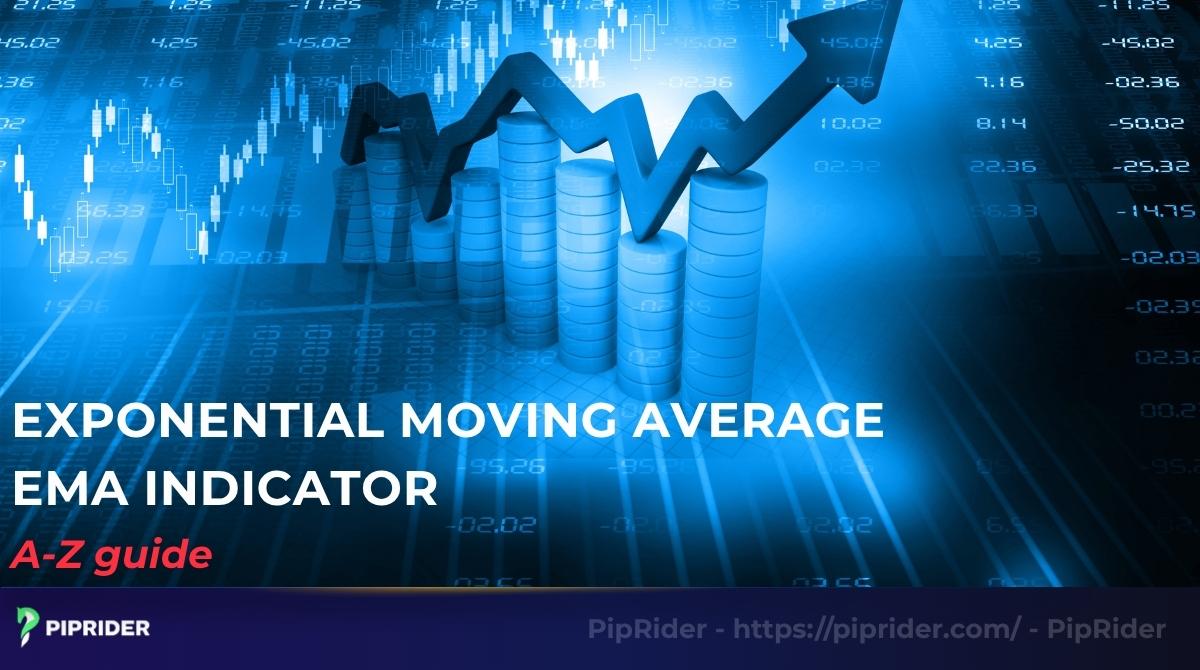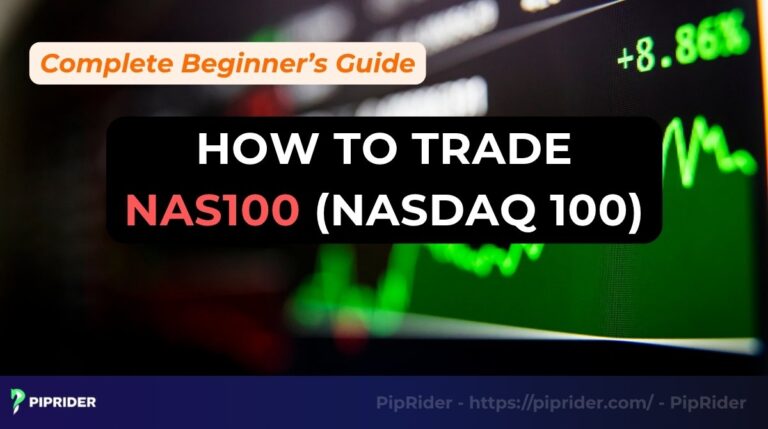In the world of technical analysis, traders are constantly searching for clarity amidst the noise of market price fluctuations. The Exponential Moving Averages EMA indicator is a foundational tool designed to provide that clarity. It’s a dynamic and responsive moving average that helps traders identify the underlying trend and momentum with greater speed and precision than its counterparts.
Piprider’s guide will serve as your complete manual, with the EMA explained not as a dry formula, but as a practical tool for real-world trading strategy. We’ll explore its nuances, its strengths, and the battle-tested strategies that professionals use every day.
Key Takeaways
- The EMA prioritizes recent data, allowing it to react faster to market changes than a Simple Moving Average (SMA).
- Its core function is to define the trend: a price above the EMA indicates a bullish trend, while a price below it signals a bearish trend.
- The EMA acts as a dynamic support and resistance line that the price often respects.
- Crossovers between different EMAs signal significant momentum shifts.
- It is a trend-following, lagging indicator that is not reliable in choppy or sideways markets.
1. What is the Exponential Moving Averages EMA indicator?
The Exponential Moving Average (EMA) is a technical indicator that smooths out price data by giving more importance to recent prices. Unlike a Simple Moving Average (SMA), which treats all data equally, the EMA is highly responsive.
This key feature is why it was championed by legendary trend-following trader Ed Seykota. He built his trading system around Exponential Moving Averages to define the trend direction (FinancialWisdomTV, 2019).
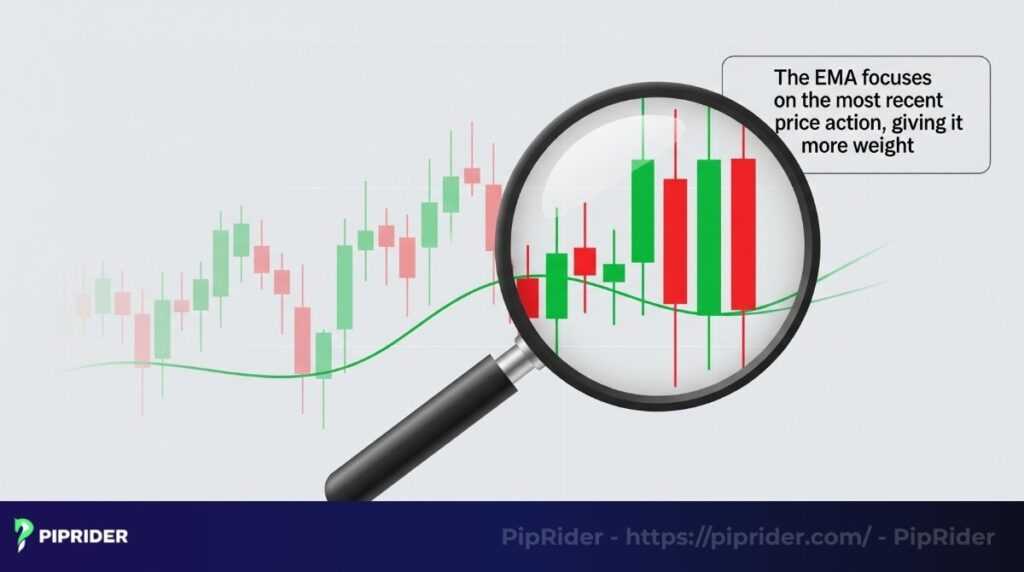
Think of it this way: If you were trying to gauge the mood of a crowd, would you give equal weight to an opinion from an hour ago as you would to one from a minute ago? Probably not. The EMA operates on the same logic. This makes it a preferred tool for traders who need to react quickly to new information and momentum shifts in fast-moving markets like Forex trading, where price dynamics are constantly in flux.
2. The key difference between EMA vs. SMA
EMA vs. SMA comparison is the critical distinction, as it fundamentally changes how traders use each tool. While both are moving averages, their personalities are completely different, born from their underlying math.
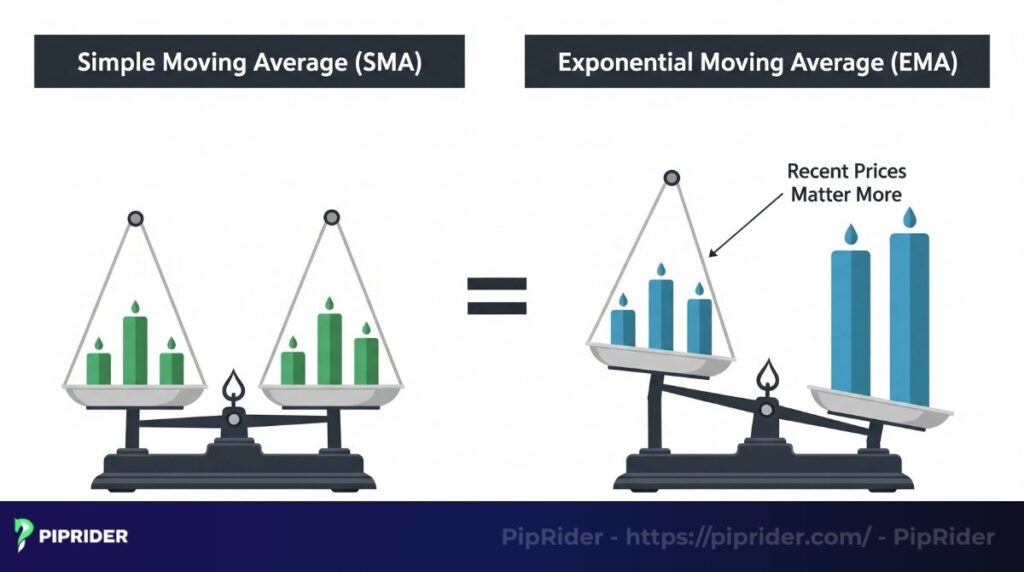
2.1. Simple Moving Average (SMA): a “democrat”
SMA calculates a simple average where every single data point from historical data has an equal vote. This makes it incredibly smooth and stable, moving like a large cruise ship. The indicator provides a reliable, long-term heading but is very slow to react. Traders rely on the SMA (especially the 200 SMA) as the “bedrock” that defines the entire market landscape and establishes long-term bias.
2.2. Exponential Moving Average (EMA): a “meritocrat”
EMA gives more influence to the most recent prices, causing it to respond much more swiftly, like a speedboat. Traders use the EMA for its agility, providing a better reflection of the market’s current energy.
This distinction has been key: While using the SMA for strategic, big-picture analysis, traders use a faster EMA (like the 21 or 50 EMA) for more tactical decisions, such as finding precise entry points on pullbacks within the larger trend.
2.3. EMA vs. SMA: A Quick Comparison
| Feature | Simple Moving Average (SMA) | Exponential Moving Average (EMA) |
| Calculation | Every data point has equal importance. | Gives more weight to recent prices. |
| Responsiveness | Slower to react to price changes. | Faster to react to price changes. |
| Best use | Identifying long-term, underlying trends. | Finding tactical entry and exit points. |
| Analogy | A stable, slow-moving cruise ship. | A fast, agile speedboat. |
| Key trait | Smoothness and reliability. | Sensitivity and agility. |
Read more:
A-Z Guide To Using The Half Trend Indicator Effectively
Guppy Multiple Moving Average: Unlock Forex Strategies 2025
Fractal Trading: A Breakout Strategy Guide For Forex Traders
3. 3-Step Calculating the Exponential Moving Average (The EMA formula)
Traders will likely never have to calculate this by hand, but understanding its logic is what separates a novice from an informed trader. When understanding the mechanics behind its speed, traders can have more faith in its signals. The calculation involves three steps:
- Step 1: First, an initial SMA is calculated to get a starting point.
- Step 2: Next, a weighting multiplier is determined. This smoothing factor is determined by the formula:
| Multiplier = [2 ÷ (Time Periods + 1)] |
- Step 3: Finally, the current EMA is calculated using a formula that heavily incorporates the previous day’s EMA and the current price, modified by the multiplier.
The critical element that gives the Exponential Moving Averages EMA indicator its unique character is this weighting multiplier.
- A shorter EMA period (like a 9 EMA) results in a larger multiplier, meaning it gives even more weight to recent prices and has a “shorter memory.”
- A longer EMA period (like a 200 EMA) has a smaller multiplier and a “longer memory,” making it smoother. This is the core of its smoothing factor.
4. Interpreting market trends with the EMA Indicator
Interpreting the EMA is a visual skill. It provides a clean, flowing line on your chart that tells a story about the market’s health and direction.
Defining trend direction
A confirmed uptrend is identified when price remains consistently above an EMA that is also angled upwards. If the price is trading below a downward-sloping EMA, you are in a downtrend.
Gauging dynamic supports and resistances
In a strong, healthy trend, the EMA line acts like a moving “line in the sand.” Price will often pull back to this line, “kiss” it, and then bounce off as buyers (in an uptrend) or sellers (in a downtrend) step in to defend the trend. This predictable behavior creates high-probability entry zones. This is a crucial element of analyzing price action.
5. Core EMA trading strategies
Now let’s translate this knowledge into actionable trading strategies. These three methods are staples in both retail and professional trading.
5.1. The EMA crossover strategy (2-line crossover)
This is a classic momentum strategy that uses a faster EMA to gauge short-term momentum and a slower EMA to define the underlying trend. A crossover signals a potential power shift.
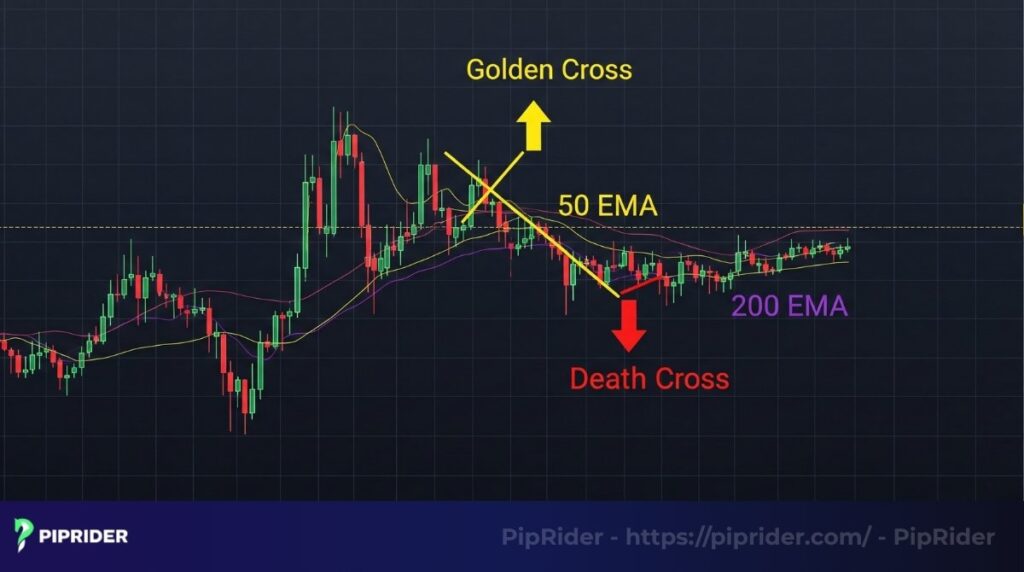
- Buy signal: The chart shows that a buy signal occurs when the faster EMA (e.g., the 21 EMA) crosses decisively above the slower EMA (e.g., the 50 EMA). This suggests that short-term buying pressure is now strong enough to influence the medium-term trend.
- Sell signal: A sell signal is indicated when the shorter-period EMA moves beneath the longer-period EMA, indicating that bearish momentum is taking control.
A crucial note: A crossover is just an alert, not a blind entry signal. Its reliability increases dramatically if it happens after a clear period of price consolidation.
5.2. The golden cross and death cross
These are two specific, very powerful crossover signals that use the 50 EMA and the 200 EMA. Because these are long-term settings, they are watched by institutional funds and can often become self-fulfilling prophecies.

On the chart above, the major bullish event happens when the 50-period EMA moves above the 200-period EMA, typically analyzed on a high timeframe like the Daily chart. It is considered a very strong, long-term bullish signal, often marking the beginning of a major market uptrend.
Conversely, this major bearish signal occurs when the 50 EMA moves below the 200 EMA. It is a major warning sign that a long-term downtrend or bear market could be starting.
5.3. The EMA ribbon strategy (Advanced)
The EMA ribbon strategy involves plotting a series of EMAs (e.g., 10, 20, 30, 40, 50, 60) on the chart. This creates a beautiful, visual “ribbon” that tells a deep story about the trend.

How to read it: Think of the ribbon as a river of momentum. If the ribbon’s lines begin to squeeze together, flatten out, or get intertwined, it serves as a distinct visual cue that the trend’s momentum is fading and the market is likely entering a consolidation phase. Understanding this complex price action is key.
6. Pros and cons of the Exponential Moving Average
For effective Exponential Moving Averages EMA indicator application, a trader must have a realistic understanding of its advantages and limitations.
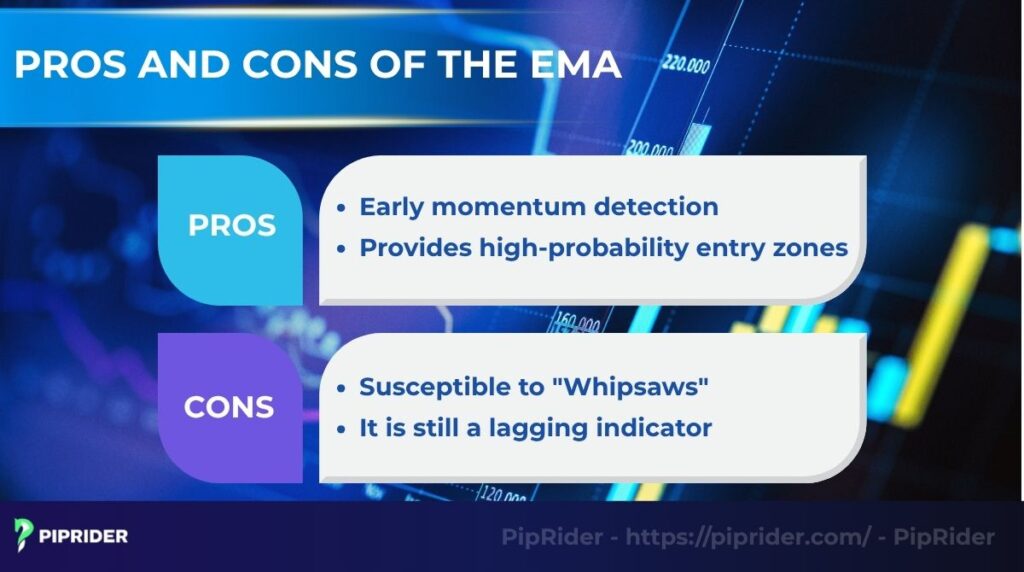
6.1. Pros of the EMA
Despite its limitations, the EMA’s responsiveness offers several key advantages for traders.
- Early momentum detection: Its primary strength is its responsiveness. It can signal a change in momentum faster than a Simple Moving Average (SMA), potentially giving you a head start on a new trend.
- Reliable entry zones: Because it tracks price so closely, its use as a dynamic support or resistance level is extremely reliable for finding pullback entries in a strong trend.
6.2. Cons of the EMA
However, the very sensitivity that makes the EMA so powerful also gives rise to its most significant disadvantages.
- Whipsaw susceptibility: The EMA’s vulnerability to whipsaws is its kryptonite. Because it’s so sensitive, it can be easily faked out by meaningless price fluctuations in a sideways, ranging market, leading to a series of frustrating false signals. This can lead to inaccurate conclusions about asset prices.
- Its lagging nature: This is a crucial point to remember. The EMA cannot predict a new trend; its function is to confirm price movements that are already underway.
7. How to choose the best EMA settings for your strategy
Selecting an Exponential Moving Averages EMA indicator setting is similar to a golfer picking a club; the right tool must be chosen for the specific situation. There is no single “best” setting, only the best setting for your specific trading style.

- Short-term EMAs (e.g., 9, 12, 21): These are the tools of day traders and scalpers. They hug the price very tightly and give very early signals. The 21 EMA is a workhorse for many swing traders as it provides a good balance on the H1 and H4 charts.
- Medium-term EMAs (e.g., 50): The 50 EMA is a widely respected line in the sand. Many traders use it as a primary trend filter. Don’t consider a buy trade if the price is below the 50 EMA, or a sell trade if it’s above.
- Long-term EMAs (e.g., 100, 200): These are the tools of position traders and investors. The 200 EMA is arguably the most-watched technical indicator in the world. When the price is above the 200 EMA, large institutions consider the asset to be in a long-term bull market, and vice-versa.
8. Tips for using the Exponential Moving Average in Forex
Here are some professional tips that go beyond the basics and can significantly improve your results with the EMA.
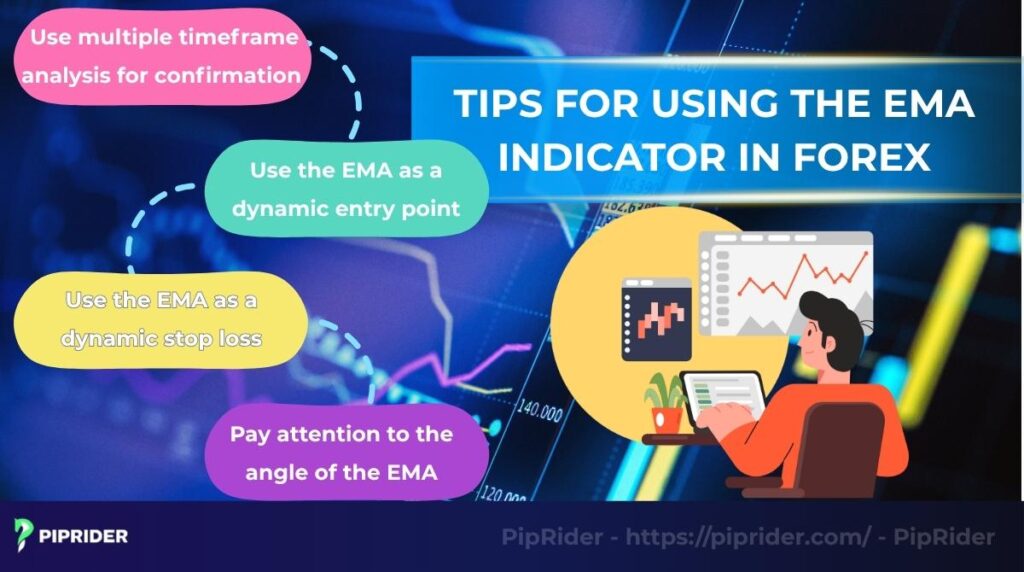
8.1. Use multiple timeframe analysis for confirmation
Prior to entering a trade, you must check a higher timeframe. Should you see a beautiful buy setup on an H1 chart as price pulls back toward the 21 EMA, spend 10 seconds looking at the Daily chart. With price on that chart also above the 50 EMA, you now have a much higher-probability trade because short-term and long-term trends are aligned.
8.2. Use the EMA as a dynamic entry point (Pullbacks)
Wait for pullbacks. Instead of buying when the price is extended and far away from the EMA, have the patience to wait for it to pull back and “test” a key EMA. This “area of value” is where you will often find the best risk/reward entries.
8.3. Use the EMA as a dynamic stop loss
In a fast-moving trend, the Exponential Moving Averages EMA indicator can help you manage your trade. A common technique is to trail your stop loss just below a key EMA (like the 21 EMA). The logic is simple: a decisive close below this line would signify that the short-term momentum has broken, giving you a valid, non-emotional reason to exit the trade and protect your profits.
8.4. Pay attention to the angle of the EMA
This is a subtle but critical tip. Don’t just look at the price’s position relative to the EMA; look at the angle of the EMA itself. When you see an EMA rising or falling at a sharp angle (around 45 degrees), it signals a strong and healthy trend. A flat, horizontal EMA is a clear visual sign of a weak, choppy, and unpredictable market, a market you should probably avoid.
9. Common pitfalls to avoid with the Exponential Moving Average
Even the most powerful tools can be misused. To truly harness the Exponential Moving Average (EMA), you need to be aware of the common mistakes traders often make. Avoiding these pitfalls can significantly improve your trading results.
- Misusing it in a ranging market: The most common error traders make. The EMA, as a trend-following indicator, will provide confusing and contradictory signals when employed in the absence of a trend. This is a particularly important point, because market volatility can often mislead traders into thinking a trend has begun when one has not.
- Blindly trading crossover: Seeing a fast EMA cross a slow one and immediately entering a trade without any other confirmation is a recipe for disaster. This is context-blind trading. Always confirm a crossover with supporting price action.
- Fighting the long-term trend: Taking a short-term buy signal on the H1 chart when the price is trading deep below the 200 EMA on the Daily chart is like trying to swim against a powerful ocean current. It’s a low-probability bet.
- Misunderstanding support levels and resistance levels: A common mistake is to treat the EMA as an absolute level. It’s a dynamic zone, not a hard line, and expecting it to hold every time can lead to losses.
10. FAQs about the Exponential Moving Average
11. Conclusion
The Exponential Moving Averages EMA indicator is a cornerstone of modern technical analysis for a reason: it is simple, robust, and incredibly effective at identifying the direction and momentum of market trends.
By understanding the core difference between the EMA and SMA, mastering the key trading strategies like crossovers and pullbacks, and always using it in the context of the broader market, you can make it a powerful ally in your trading journey.
If you have any questions after learning about this indicator, feel free to leave a comment below Piprider‘s article. For a broader overview of other trading indicators, be sure to read more of our articles in the Trading Strategies category.


